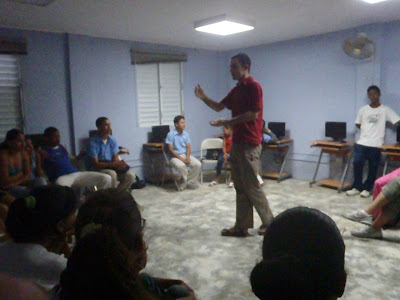 |
| This array of inverters and batteries attached to Cassidy's lab collects energy from solar and wind sources. |
By three o'clock the next day, it was obvious that the driver of the public pickup we had consulted the day before had given us bad information when he assured us there would be a pickup at 1:00 pm to take me to Moca. This is a feature of the Dominican Culture; the answers you get from people often have more to do with saving face or telling you what is supposed that you want to hear than they do with providing accurate and useful information.
Luckily, there was a single seat available in a jeep that was headed my way. It was less than ideal since Andrew was also leaving town and had planned to help me negotiate the bus system on the trip back, but in the moment when the jeep arrived it was a matter of taking it or running the risk of arriving home in the capital after dark. I opted for the former, and as I watched the breathtaking mountain views unfold to the sound of bachata music from the stereo, I reflected that for the first time since I arrived in the country, I was alone traveling long-distance without the guidance or companionship of other Americans. It was interesting to remember all the times I had done likewise in Guatemala and recognize how much more quickly that transition from dependent to independent had taken place.
 |
| Hiking up to a viewpoint before lunch |
Once in Moca, I found the bus station and headed for what I judged to be the ticket window by the appearance of big letters over it that read "ticket window". Behind the counter I found a woman punching keys on a cell phone. "When does the next bus leave for the capital?" I asked. In response she gave me a look that told me I was the stupidest person possibly imaginable and proceeded to look away and place the phone to her ear. A man who was among five or six people inexplicably loitering in the ticket office must have taken pity on me. He pointed to a bus and said "Santo Domingo". I suppose I was expected to intuit this.
On the way to Santo Domingo, our already full bus took on about a third of the passengers of another bus we found broken down alongside the road. Being based in the northwestern suburbs of Santo Domingo, I was among the first people off. This meant several people had to get off to make way. Even still, it was a tight squeeze with my three bags.





















